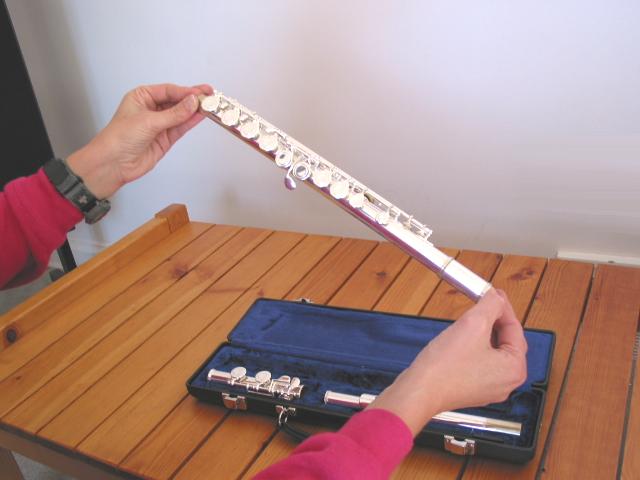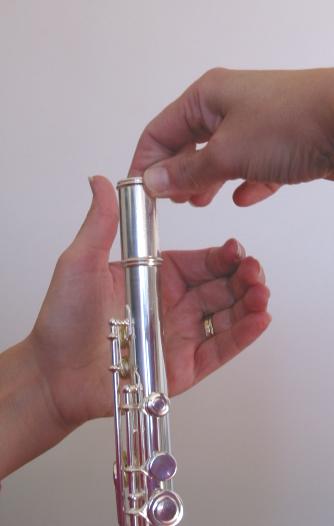Home | Audio | DIY | Guitar | iPods | Music | Brain/Problem Solving | Links| Site Map
This work is licensed under a Creative Commons License.
Flute Care and Maintenance
The flute is probably the most fragile of all the band instruments. It is very delicate having many keys that move up and down covering the the tone holes. These keys are made of soft metal and can easily be bent. The most common problem that occurs with flutes is bent keys. If a key is bent even just slightly it will not cover or seal the hole completely and therefore the flute will leak air. Consequently the flute will play poorly or not at all.
Please remember that the biggest enemy of any flute is the player's hands. Anyone can make a flute non-playable in a matter of seconds and they may not even know they are doing it. If you do not assemble and disassemble your flute properly YOU WILL DAMAGE YOUR FLUTE.
Also please remember that bent keys are Never Under Warranty.Do you know how to assemble a flute??? Silly question? Anyone can assemble a flute you say. Can you assemble and disassemble a flute CORRECTLY, so that you don't cause any damage to the keys?
Surprisingly many players can not. Any flute can be put out of commission in a matter of seconds if the keys get bent and put out of alignment. The easiest way to bend the keys of a flute is to assemble and disassemble it the wrong way. Many players are not even aware that they are damaging their flute. All they know is that their flute is in the shop being adjusted all the time.
The main purpose of assembling the flute correctly is to avoid touching the keys. It's simple, If you don't touch the keys, you can't bend the keys.Now then, here is the correct way. Forget the way you were taught and any bad habits you may have developed. Do it this way and you will never have to see a repair technician. This will save you much aggravation and money.
Assembly
We must first know how to identify the three different parts of a flute.
1. The piece that touches your mouth and has no keys is the HEAD JOINT.
2. The largest piece with the most keys is the BODY
3. The smallest piece is the FOOT JOINT

Before we go any further, you must know which is your RIGHT hand and your LEFT hand. Take a moment and figure this out first!
As mentioned above, the long part is the body of the flute. Pick up the body by the edges. Always pick up the pieces by the edges, never by the keys.
Hold the body of the flute in your LEFT hand. Put your left hand where the writing or brand logo is.
This is a good spot to hold it because there are no keys here. You can therefore squeeze it as hard as you want and you will not hurt the flute.Your LEFT hand DOES NOT MOVE from this spot during the whole assembly or disassembly procedure.
Pick up the headjoint in your RIGHT hand and place it into the body of the flute. Do not push it in as far as it goes. Leave about a quarter inch of the unplated part of the headjoint showing. This is where you tune the flute. So if you push it in all the way, you will be too sharp.
Line up the embouchure hole with the keys, so that they are in line.
Next pick up the foot joint from the side closest to the edge of the case in your RIGHT hand. Remember your LEFT hand does not move from its location.
Turn the footjoint around and let gravity slide it down in your hand until you are clamping the two large keys by the edge of your palm. This is very critical. You must have your THUMB UP above the keys and not around the bottom of the piece. This is so that when you assemble the footjoint and your hand slips you do not bend the keys below your palm. If your thumb was wrapped around the footjoint you would bend the keys when you twist on the footjoint. If fact the C# key on the footjoint is the most common key to get bent on a flute. Its usually bent 10 minutes after the flute is purchased.
Here is the correct position of your hand over the footjoint. Study it carefully.
Line up the headjoint so that the post that looks like a little round ball closest to the edge of the footjoint lines up with the center of the closest key on the body of the flute.
Disassembly
You disassemble the flute exactly the same way as you have assembled it but in reverse order. Reverse order means that whatever you did last you do first.
Remember you hold the flute in your LEFT hand where the writing is and your LEFT hand never moves from this spot during the whole operation.
Hold the flute again in your left hand where the writing of the brand-name is. Remember your left hand does not move from this spot during the whole operation.
Clamp the foot joint with you right hand and your thumb on top.
Turn the foot joint around in your right hand and place it in the case.
Now, with your right hand you remove the head joint. Your left hand still has not moved form its original location.

Now you grab the flute with your RIGHT hand and release your LEFT hand for the first time during the whole operation. Your LEFT hand now holds the flute at the opposite end of the body.
Place the body of the flute in the case. Well there you go. You have assembled and disassembled your flute without touching any of the keys on the body and only clamping the keys down on the footjoint. You have not bent any keys and your flute remained in perfect alignment. Congratulations. Now, practice this 127 times and you will be an expert and if you do it this way every time then you will never have to spend money on flute repairs.
Cleaning
(actually its drying)
You don't actually clean a flute, you dry it by removing the moisture from the inside. The pads of a flute do not like moisture. Do this drying procedure after every time you play.
So, take a cloth, I use a J cloth that is made for the medical industry but it can be any cloth as long as its not to big or not too small. I fold the cloth in half lengthwise and thread one of the edges through the hole in the cleaning rod.
Wrap the cloth over the top of the rod so that you get the cloth all the way in as far as the rod can reach. Now wrap the cloth tight all the way down the rod and hold the cloth at the end of the rod in your RIGHT hand. This way the cloth will never bunch up and get stuck in your instrument.
The most important part of the flute to dry is the headjoint because it gets the most wet. Push the rod all the way in, twisting it as you move it in and out.
If you play for a longer period then also dry the body of the flute by first inserting the cleaning rod from one side and then the other side.
Unravel the cloth, fold it in half and then in half again. Very neatly.
Now place it in the case on the headjoint side because there will be less keys on that side. You don't want to squish any keys. Now you are all done. Time to watch TV.
IMPORTANT
Don't buy anything called a "cleaning kit" for your flute. All you need is a rod and a cloth. The rod should always come free with your flute and you can find an appropriate cloth. You should never do any other maintenance to your flute. I don't even recommend that you polish your flute. Never use any silver polish. It is abrasive like sandpaper and will either remove the silver plating on your flute or it will get into your keywork and grind away. Ouch! You can use a silver polishing cloth, but why, as soon as you touch the flute, your fingerprints will be on it again. Remember it is normal for a silver or a silver plated flute to tarnish. You can have it de-tarnished by a repair technician when the pads are replaced every 5 to 10 years.
You do not have to take your flute in for regular check ups. This is just a way some repair technicians pretend that they are doctors and ask you to come back for a visit regularly. They want to be as rich as doctors by having you return for no reason. Remember if your flute is not broken, it cannot be fixed. First determine if your flute is indeed broken by getting a second and third opinion. You can be sure that anything you take to a repair technician will be considered broken. Even if your keys are bent and out of alignment it shouldn't cost more than dinner for four at McDonalds.
Just make sure you take care of your flute by assembling and disassembling it properly and never dropping it, banging it against furniture, hitting your brother or sister with it or sitting on it.
Home | Audio | DIY | Guitar | iPods | Music | Links | Brain and Problem Solving | Site Map | Contact